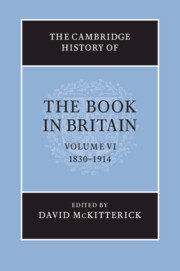Book contents
- Frontmatter
- Introduction
- 1 Changes in the look of the book
- 2 The illustration revolution
- 3 The serial revolution
- 4 Authorship
- 5 Copyright
- 6 Distribution
- 7 Reading
- 8 Mass markets: religion
- 9 Mass markets: education
- 10 Mass markets: children’s books
- 11 Mass markets: literature
- 12 Science, technology and mathematics
- 13 Publishing for leisure
- 14 Publishing for trades and professions
- 15 Organising knowledge in print
- 16 The information revolution
- 17 A place in the world
- 18 Second-hand and old books
- 19 A year of publishing: 1891
- 20 Following up The reading nation
- Bibliography
- Index
- Plate Sections
- References
8 - Mass markets: religion
Published online by Cambridge University Press: 28 March 2010
- Frontmatter
- Introduction
- 1 Changes in the look of the book
- 2 The illustration revolution
- 3 The serial revolution
- 4 Authorship
- 5 Copyright
- 6 Distribution
- 7 Reading
- 8 Mass markets: religion
- 9 Mass markets: education
- 10 Mass markets: children’s books
- 11 Mass markets: literature
- 12 Science, technology and mathematics
- 13 Publishing for leisure
- 14 Publishing for trades and professions
- 15 Organising knowledge in print
- 16 The information revolution
- 17 A place in the world
- 18 Second-hand and old books
- 19 A year of publishing: 1891
- 20 Following up The reading nation
- Bibliography
- Index
- Plate Sections
- References
Summary
In 1890, F. W. Farrar, Archdeacon of Westminster and author of The life of Christ (1874) and The life and work of St Paul (1879), lectured the Church Congress on ‘The ethics of commerce’. In his broadside against adulteration, hucksterism and vulgar advertising, Farrar commented sharply on the ‘sweating publishers’ who passed on to authors only a hundredth of the profits from their works. Surely he was not referring to Cassell, the publisher of his two best-sellers? Feeling their honour slighted, they wrote to The Times to defend the generosity of their dealings with him. Farrar had been ‘comparatively unknown’ when in 1870 they proposed that he write a life of Christ, offering him £500 plus £100 for a research trip to Palestine. After their extensive advertising helped make the book a huge success, they gladly paid out £1,405 in extra-contractual gratuities, making £2,005 for Farrar in all. He was offered £1,000 for St Paul, a sum Cassell doubled and added a royalty to when Farrar, having signed a contract, suggested he might make a better deal elsewhere. Together with extra gratuities, he received £4,333 17s 1d for the book. Mortified by this publicity, Farrar sent a grand rebuke to The Times, arguing that the ‘altogether distasteful’ advertising campaign for Christ had been nothing to do with him, protesting that Cassell had paraded their generosity while keeping quiet about their profits, and pointedly omitting the firm from the list of his publishers that had his ‘gratitude’ and ‘esteem’.
Keywords
- Type
- Chapter
- Information
- The Cambridge History of the Book in Britain , pp. 324 - 358Publisher: Cambridge University PressPrint publication year: 2009
References
- 5
- Cited by

